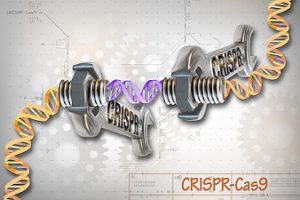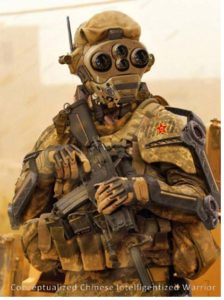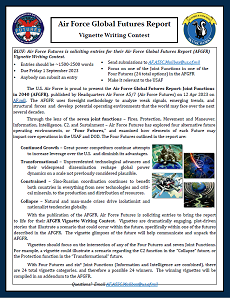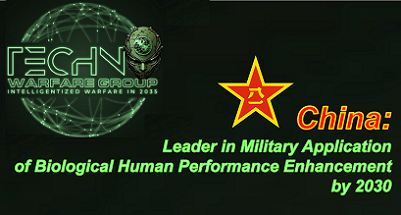Gene editing could play a significant role in the execution of China’s Intelligentized warfare concept by enabling the country to create genetically modified soldiers with enhanced physical and cognitive abilities.
[Editor’s Note: The Army’s Mad Scientist Laboratory is pleased to feature another excerpt from the United States Army War College (USAWC) Team Techno-Warfare Group’s Techno Sentient Warfare in 2035. This report documents the findings from their group Strategic Research Requirement that occurred over eight months (from October 2022 to May 2023).
 The Team Techno-Warfare Group consisted of COL Leslie Carlson (USA), LTC Fidel Arvelo (USA), LTC Phillip Cain (USA), LTC Samuel Meyer (USA), and Col (s) Dorian Hatcher (USSF). Their requirement synthesized and analyzed open-source information and interviews with subject-matter experts to answer the following strategic question posed by the Deputy Chief of Staff, G-2, U.S. Army Training and Doctrine Command: What will Intelligentized warfare look like in 2035, and what skill sets will leaders need to win in this environment?
The Team Techno-Warfare Group consisted of COL Leslie Carlson (USA), LTC Fidel Arvelo (USA), LTC Phillip Cain (USA), LTC Samuel Meyer (USA), and Col (s) Dorian Hatcher (USSF). Their requirement synthesized and analyzed open-source information and interviews with subject-matter experts to answer the following strategic question posed by the Deputy Chief of Staff, G-2, U.S. Army Training and Doctrine Command: What will Intelligentized warfare look like in 2035, and what skill sets will leaders need to win in this environment?
Regular readers of the Mad Scientist Laboratory will recall a recurrent theme permeating our on-going exploration of the Operational Environment — the Asymmetry in Ethics that exists between the West and our pacing threat – China. Asymmetric ethical standards grant China an advantage in Science and Technology (S&T) development. China perceives itself as an old culture with differing needs and values from the West, in which ethical standards in  research are regarded as “flexible,” and may appear “lax” by Western standards. This mindset, along with robust research funding, attracts international talent, impacts S&T development (commercial and military) timelines, and fortifies China’s capability in economic, biomedical, and political spheres of influence and power. Today’s post features Col (s) Dorian Hatcher’s piece exploring how this Asymmetry in Ethics will enable China to emerge as the world’s leading innovator in biological Human Performance Enhancement Technologies (HPET) and its military applications by 2030. Note that ChatGPT, Perplexity AI, Jasper AI, Google Translator, and Speechify.com ask Ai Bot were utilized in this essay’s argument research and construction — Read on!]
research are regarded as “flexible,” and may appear “lax” by Western standards. This mindset, along with robust research funding, attracts international talent, impacts S&T development (commercial and military) timelines, and fortifies China’s capability in economic, biomedical, and political spheres of influence and power. Today’s post features Col (s) Dorian Hatcher’s piece exploring how this Asymmetry in Ethics will enable China to emerge as the world’s leading innovator in biological Human Performance Enhancement Technologies (HPET) and its military applications by 2030. Note that ChatGPT, Perplexity AI, Jasper AI, Google Translator, and Speechify.com ask Ai Bot were utilized in this essay’s argument research and construction — Read on!]
Executive Summary
 With rapid advances in Chinese HPET and the cooperation of a complicit regulatory environment, it is highly likely (71-85%) that China will lead the world in developing CRISPR Cas9, Gene Editing, and Gene Doping technological capabilities by 2030. Utilizing a Civil-Military Fusion approach to biotechnology as a dual-use technology, it is highly likely (71-85%) the widespread application of Gene-related HPET will begin in 2030, particularly within military applications. These advancements promise incredible outcomes such as eliminating diseases, improved strength levels & vision, and decreased fatigue all contributing to enhanced overall human capability.
With rapid advances in Chinese HPET and the cooperation of a complicit regulatory environment, it is highly likely (71-85%) that China will lead the world in developing CRISPR Cas9, Gene Editing, and Gene Doping technological capabilities by 2030. Utilizing a Civil-Military Fusion approach to biotechnology as a dual-use technology, it is highly likely (71-85%) the widespread application of Gene-related HPET will begin in 2030, particularly within military applications. These advancements promise incredible outcomes such as eliminating diseases, improved strength levels & vision, and decreased fatigue all contributing to enhanced overall human capability.
Discussion
 China’s recent advances in HPET include gene editing, gene doping, and CRISPR, which can enhance human physical and cognitive abilities. In particular, Chinese scientists have made advancements in gene editing using CRISPR-Cas9 technology. This technology has the potential to modify genetic traits and alter phenotypes (Phenotypes refer to an organism’s observable physical, behavioral, and physiological characteristics resulting from the interaction between its genotype — the genetic makeup of the organism).
China’s recent advances in HPET include gene editing, gene doping, and CRISPR, which can enhance human physical and cognitive abilities. In particular, Chinese scientists have made advancements in gene editing using CRISPR-Cas9 technology. This technology has the potential to modify genetic traits and alter phenotypes (Phenotypes refer to an organism’s observable physical, behavioral, and physiological characteristics resulting from the interaction between its genotype — the genetic makeup of the organism).
CRISPR is a revolutionary gene editing tool that allows scientists to precisely target specific sections of DNA and make edits at will. By doing so, they can  enhance particular characteristics or even remove undesirable traits. For example, researchers at Shanghai’s Institute for Advanced Medicine have used CRISPR to successfully improve the production of red blood cells in mice with anemia. The potential applications for this technology range from practical medical treatments to radical military use, such as creating “super soldiers” with enhanced physical or cognitive abilities.
enhance particular characteristics or even remove undesirable traits. For example, researchers at Shanghai’s Institute for Advanced Medicine have used CRISPR to successfully improve the production of red blood cells in mice with anemia. The potential applications for this technology range from practical medical treatments to radical military use, such as creating “super soldiers” with enhanced physical or cognitive abilities.
Dr. Joy Zhang, a world-renowned specialist in gene editing governance from Kent University Canterbury, warns that China might be prone to “regulatory negligence” regarding genetic engineering  following a controversial claim five years ago of a Chinese scientist producing the first-ever gene-edited babies. Newly established Chinese regulatory guidance on the importance of ethical supervision of gene editing is inadequate. Specifically, there is no clear indication of how or if the newly established regulations apply to the Chinese private and military sectors.
following a controversial claim five years ago of a Chinese scientist producing the first-ever gene-edited babies. Newly established Chinese regulatory guidance on the importance of ethical supervision of gene editing is inadequate. Specifically, there is no clear indication of how or if the newly established regulations apply to the Chinese private and military sectors.
John Radcliffe, the former Director of National Intelligence, has already indicated that China is working to build “super soldiers.” “There are no ethical boundaries to Beijing’s pursuit of power,” wrote Director Radcliffe.
China’s national strategy of civil-military fusion endeavors a superior biotechnology program focused on gene editing and HPETs to create specific traits, such as high intelligence or reptilian night vision in Chinese soldiers.  However, this remains a complex and delicate undertaking. As these desired features are influenced by many genetic locations with only minute impacts on the specific outcome, reaching their desired result without introducing dangerous side effects remains an ambitious task that lies more than five to ten years away. Over the next five years, scientists anticipate enhanced precision in editing DNA to repair any damage to a sequence. While particular challenges may linger, tremendous progress is expected in searching for new genetic repair solutions.
However, this remains a complex and delicate undertaking. As these desired features are influenced by many genetic locations with only minute impacts on the specific outcome, reaching their desired result without introducing dangerous side effects remains an ambitious task that lies more than five to ten years away. Over the next five years, scientists anticipate enhanced precision in editing DNA to repair any damage to a sequence. While particular challenges may linger, tremendous progress is expected in searching for new genetic repair solutions.
Recent advancements in CRISPR Cpf1 enzyme gene editing have been integrated into China’s military programs, which are focused on surpassing the military power of the United States. Given the favorable regulatory environment in China with limited ethical restrictions, the country is highly likely (71-85%) to become a leader in Gene-related HPET. Notably, the most-frequent author of articles on CRISPR published in 2016 or later is the Chinese Academy of Science. China initiated twice as many CRISPR trials in a three-year period as the United States.
China remains at the forefront of HPET research and development due to its increasingly sophisticated laboratory capabilities and substantial investment in cutting-edge science and technology initiatives. China is expected to continue to outpace the United States in the future, which mandates clear regulations to ensure that all involved parties apply technological advancements responsibly and ethically in China and abroad. The United States must monitor the progress of Chinese HPET innovation by actively tracking critical indicators such as program launches, government grants, joint ventures, conferences, patents, and publications and assessing related  applications, breakthroughs, and setbacks to anticipate the ever-evolving landscape of Chinese biological and technological “super soldier” advancement. Gene editing could play a significant role in the execution of China’s Intelligentized warfare concept by enabling the country to create genetically modified soldiers with enhanced physical and cognitive abilities. By manipulating the genomes of soldiers, it may be possible to increase their resistance to fatigue, improve their reflexes, enhance their abilities to process sensory information, and more. These modifications could give Chinese soldiers a significant advantage in combat situations, allowing them to operate more effectively and with greater speed and accuracy. Chinese military researchers are already exploring the possibilities of creating genetically modified soldiers, and their advances could potentially alter the dynamics of warfare in the future.
applications, breakthroughs, and setbacks to anticipate the ever-evolving landscape of Chinese biological and technological “super soldier” advancement. Gene editing could play a significant role in the execution of China’s Intelligentized warfare concept by enabling the country to create genetically modified soldiers with enhanced physical and cognitive abilities. By manipulating the genomes of soldiers, it may be possible to increase their resistance to fatigue, improve their reflexes, enhance their abilities to process sensory information, and more. These modifications could give Chinese soldiers a significant advantage in combat situations, allowing them to operate more effectively and with greater speed and accuracy. Chinese military researchers are already exploring the possibilities of creating genetically modified soldiers, and their advances could potentially alter the dynamics of warfare in the future.
Analytic Confidence

The analytic confidence for this estimate is High. All sources generally conclude and provide examples of cogent, detailed illustrations of significant advancements in Chinese HPET, specifically concerning gene editing and the civil-military fusion between Chinese academic institutions and the military. To determine the full extent of Chinese gene editing research, ongoing analysis of the National Institute of Health database is required, as trials closely related to the Chinese Registry but lacking a Chinese identifier may be present. The majority of sources concur that China’s permissive regulatory environment provides an advantage to its military and allows limited oversight of China’s current scientific capabilities. This estimate remains sensitive to change due to its long-time span and recent advancements in CRISPR Cas9 and Cpf1 enzyme gene editing. Additional time and staffing would refine this estimate due to the volume of associated scientific literature.
If you enjoyed this post, check out Team Techno-Warfare Group‘s Techno Sentient Warfare in 2035 Final Report…
… as well as the following related TRADOC G-2 and Army Mad Scientist content:
China Landing Zone content on the TRADOC G-2‘s Operational Environment Enterprise public facing page — including the BiteSize China weekly topics, ATP 7-100.3, Chinese Tactics, People’s Liberation Army Ground Forces Quick Reference Guide, and more!
China’s Drive for Innovation Dominance, derived from proclaimed Mad Scientist Elsa Kania‘s People’s Liberation Army (PLA) Human-Machine Integration presentation [access via a non-DoD network], presented at the Mad Scientist Bio Convergence and Soldier 2050 Conference on 9 March 2018 at SRI International‘s Silicon Valley campus in Menlo Park, California
China’s Brain Trust: Will the U.S. Have the Nerve to Compete? by proclaimed Mad Scientist Dr. James Giordano, as well as his Neuroscience, Neurotechnology, and the Future of War and Neuroscience and the Weapons of War podcasts, hosted by our colleagues at the Modern Warfare Institute
Linking Brains to Machines, and Use of Neurotechnology to the Cultural and Ethical Perspectives of the Current Global Stage and Designer Genes: Made in China? by proclaimed Mad Scientist Dr. James Giordano and Joseph DeFranco
Cyborg Soldier 2050: Human/Machine Fusion and the Implications for the Future of the DOD and its associated report from the U.S. Army Combat Capabilities Development Command (DEVCOM) Chemical Biological Center
Universal Soldier, by proclaimed Mad Scientist Master Sergeant Greg A. McGowan
One Brain Chip, Please! Neuro-AI with two of the Maddest Scientists and associated podcast, with proclaimed Mad Scientists Dr. James Giordano and Dr. James Canton
Connected Warfare by COL James K. Greer (USA-Ret.)
Ethics, Morals, and Legal Implications; Ethical Dilemmas of Future Warfare; and The Ethics and the Future of War panel discussion, facilitated by LTG Jim Dubik (USA-Ret.)
The Network is the Robot, presented by proclaimed Mad Scientist Dr. Alexander Kott at the Mad Scientist Robotics, Artificial Intelligence, & Autonomy: Visioning Multi Domain Battle in 2030-2050 Conference, at Georgia Tech Research Institute, 8-9 March 2017, in Atlanta, Georgia.
Future Legal and Ethical Implications of Bio Technology, presented by proclaimed Mad Scientist Hank Greely at the Mad Scientist Bio Convergence and Soldier 2050 Conference, at SRI International, 8-9 March 2018 in Menlo Park, California.
Sine Pari, Keeping the Edge, CRISPR Convergence, and Great Power Conflict: 2040, by proclaimed Mad Scientist Howard R. Simkin
Unplanned Obsolescence, by Eric X. Hammes
>>>>REMINDER: AFGFR Vignette Writing Contest — Our Sister Service partners in the U.S. Air Force (USAF) are proud to present the Air Force Global Futures Report: Joint Functions in 2040, published by Headquarters Air Force A5/7 (aka Air Force Futures). This report is the USAF’s analogue to the U.S. Army Futures Command’s AFC Pamphlet 525-2, Future Operational Environment: Forging the Future in an Uncertain World 2035-2050.
The AFGFR highlights four future operating environments and major implications for the future force. To bring these operating environments to life, Army Mad Scientist is partnering with the Air Force Futures’ Foresight Team to conduct the AFGFR Vignette Writing Contest — based on the report’s four futures and the exploration of the Joint Functions. We are seeking vignettes with characters that make the future operating environments and associated  Joint Functions within come to life!
Joint Functions within come to life!
The AFGFR Vignette Writing Contest is open to all — anyone can submit an entry. Entries should be between 1500-2500 words in length, and are due NLT 01 September 2023. To learn more about the contest and how to submit your entry(ies), click >>>> here <<<< and read the contest flyer!
Col (s) Dorian C. Hatcher, a Space Acquisitions Officer in the United States Space Force, has an extensive military background with leadership roles, including Task Force Commander, Battalion Commander, and Counter Improvised Threat/C-UAS Force Protection Branch Chief for US Army Central. Upon his Army War College graduation, Col (s) Hatcher will become the Deputy Director of the Architecture Integration Directorate for the Assistant Secretary of the Air Force for Space Acquisition and Integration.
Disclaimer: The views expressed in this blog post do not necessarily reflect those of the U.S. Department of Defense, Department of the Army, Army Futures Command (AFC), or Training and Doctrine Command (TRADOC).



